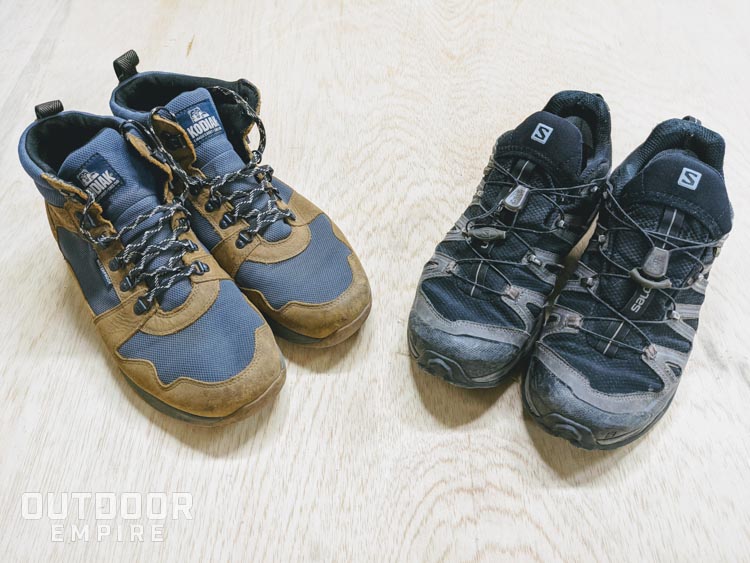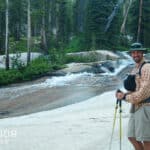I was 70 miles and 24 hours into a 100 mile race, and I was starting another big climb at the Idaho Mountain Trail Ultra Festival (IMTUF). The problem was that I wasn’t moving fast enough and soon I wouldn’t be moving at all. A large blister had developed on my right heel and it was debilitating.
I had managed to limp along for a while but my pace was getting slower. Stopped on the side of the trail, I looked at the damage. A small parade of other zombie runners filed past as I fixed my foot so that I could continue.
There is nothing that can stop you faster on a run, hike, or backpacking trip than blisters. And nothing causes blisters faster than poorly fitting boots.
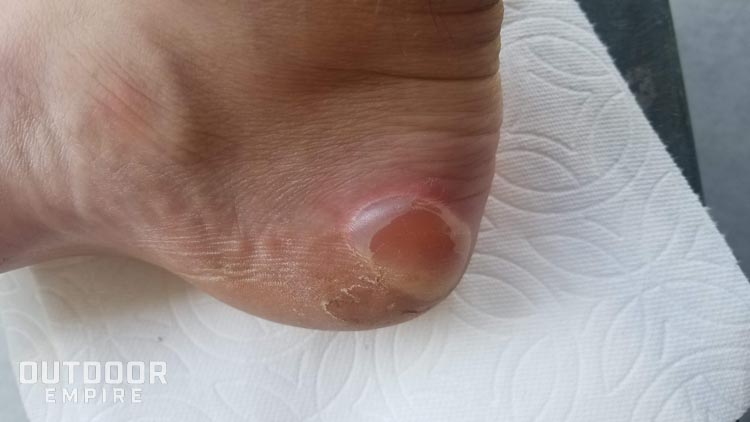
Blisters are formed by friction caused by a shearing force between the outer and middle layer of the skin. The formation of blisters is accelerated by the presence of dirt and moisture.
To mitigate blister formation when hiking, it’s important to:
- pick the right footwear for the right activity, and
- have the right fit.
Hiking shoes make sense for easy hikes while boots are better for carrying a load. Hiking boots should fit snug and your foot should not slide around to avoid blisters.
There are several other tricks and tips to prevent blisters, but we will get to that later.
Hiking Shoes vs Boots
The first question you need to ask yourself is what you are going to be doing. It is important to pick the right tool for the right task.
Hiking footwear comes in a dizzying array of options, but can be generally categorized as shoes or boots. Shoes and boots can range from lightweight and flexible to heavy duty and stiff. Each category has its own pluses and minuses.
When To Wear Shoes While Hiking
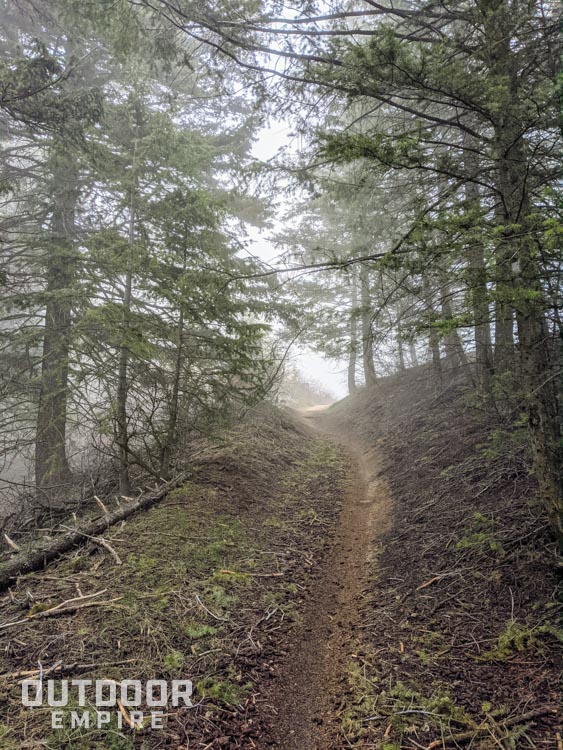
Shoes can be a great choice for everyone from day hikers to the light and fast backpacking crowd. Like a solid hydration pack, trail running shoes have also become the favorite for thru hikers.
It generally takes time for your body to become used to using shoes in the backcountry.
I might be a bit biased, but I love trail running shoes. I have worn them for everything from short hikes with my kids to multiple day, off trail backpacking trips in technical terrain. But as much as I love them there are some drawbacks.
Here are some pros and cons of wearing hiking shoes or trail running shoes when hiking:
Pros of Shoes for Hiking
- Lightweight
- Relatively little break in time
- Cheaper than some options
- Good ankle mobility
- Good ground feel
Cons of Shoes for Hiking
- No ankle support
- Relatively little protection underfoot
- Wear out quicker than other choices
- On longer trips with heavy packs, they are more suited for experienced hikers
When your pack starts to get heavier than 35 to 40 pounds and the terrain becomes more technical, it might be time to look for a little more protection. That can be found in hiking boots.
When Hiking Boots Are Better Than Hiking Shoes
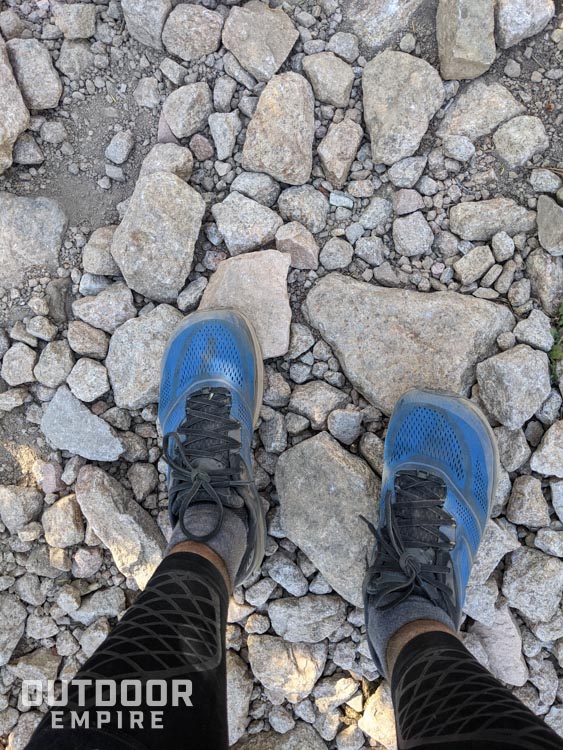
Boots have been the choice for outdoor adventures since outdoor adventure began. They are more stable than shoes and provide more protection.
If the thought of wearing shoes while wearing a pack makes your feet hurt, you will probably be more comfortable in boots.
Boots also make more sense if you plan on hiking in the spring or the fall when the weather can turn bad. The trail can be covered with snow or mud from which hiking boots will provide more protection.
Here are the main upsides and downsides to wearing hiking boots instead of hiking or trail running shoes:
Pros of Boots for Hiking
- Ankle stability
- Superior protection to the bottom of the foot
- Durable
- Warmer for three season hiking
Cons of Boots for Hiking
- Heavy
- Require more break in time
- Do not breathe as well as shoes
In recent years, the line between shoes and boots has blurred. You can find boots that fit like your favorite shoes and shoes that have plenty of beef in them.
If you’re looking for a decent pair of all around hiking boots, check out our review of the Kodiak Skogans.
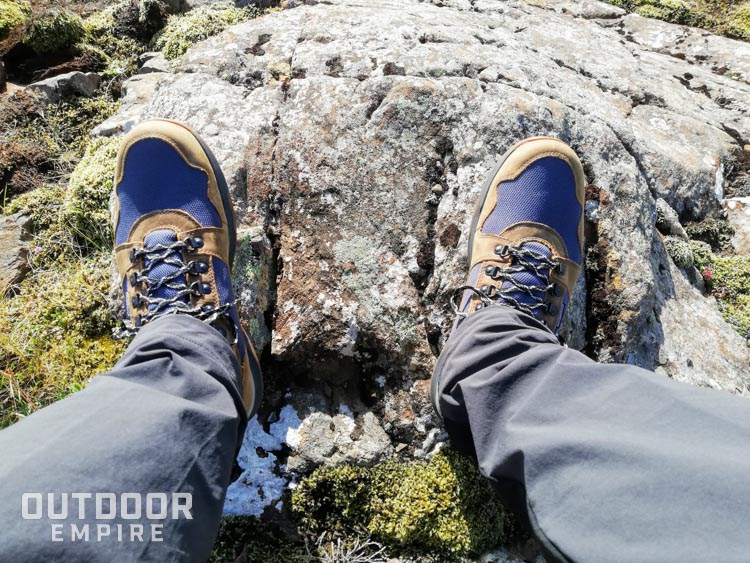
Be critical of your needs and think about buying different footwear for different types of trips if you can. For example, if you’ll be hunting you’re probably best off finding some good hunting boots and not just any hiking boot.
How Should Hiking Boots Fit?
Hiking boots should fit snugly around the ankle, heel, and arch of your foot. Your foot should not slide around, especially on a decline. There should be a little extra room in the toe box, but not so much that your toes slide or jam against the end of the boot. Overall, there should be no obvious pinch points or hot spots.
Last year I went to a podiatrist to look at some ongoing pain I have been having in my left foot. He only looked at it for a second before he said, “You are probably aware of this, but you have a large, ugly knob where your large toe attaches to your foot.”
I was in fact unaware of this, but now I will be self-conscious about it for the rest of my life. Thanks, Doc!
The moral of the story, beside the fact that I need a new podiatrist, is that we all have different feet with unique fitting issues. What works for me might not work for you.
Fit is very important and individual to you.
It is always best to fit boots at a specialty outdoor shop with a competent boot fitter. They should also have a wide range of boots. I would suggest trying on as many boots as your significant other, or the store clerk will allow.
The most important thing to me is that the boot feels good when I put it on. Any annoyances that you find in the store will be magnified each mile on the trail.
How To Try On Hiking Boots

Here are the three things to look for in a well-fitted hiking boot:
1. The Thumb Nail Test
While wearing the socks that you plan on wearing while hiking, step into the boot and stand up.
Next, push your foot forward until your toes are touching the front of the boot.
There should be about a thumb nail width gap between your heel and the back of your boot.
Unless you are a contortionist this will require the help of someone else with similar sized thumbs as you.
2. Forefoot and Ankle
This area should fit snug but not tight. It should also be comfortable with no pinching noted when walking around. The way you use the boot laces can make a difference here.
Find an incline, most outdoor specialty shops will have one, and stand facing downhill. Your foot should not slide forward.
If your foot slides forward and your toes hit the front of the boot this will lead to blackened toenails that will eventually fall off. No good!
3. Heel
The heel should be snug inside the boot and not slide up and down or side to side. Any sliding will lead to friction which, in turn, will lead to blisters.
More Hiking Boot Fitting Tips
Here are some other tips to help prevent blisters when hiking.
1. Choose Good Socks
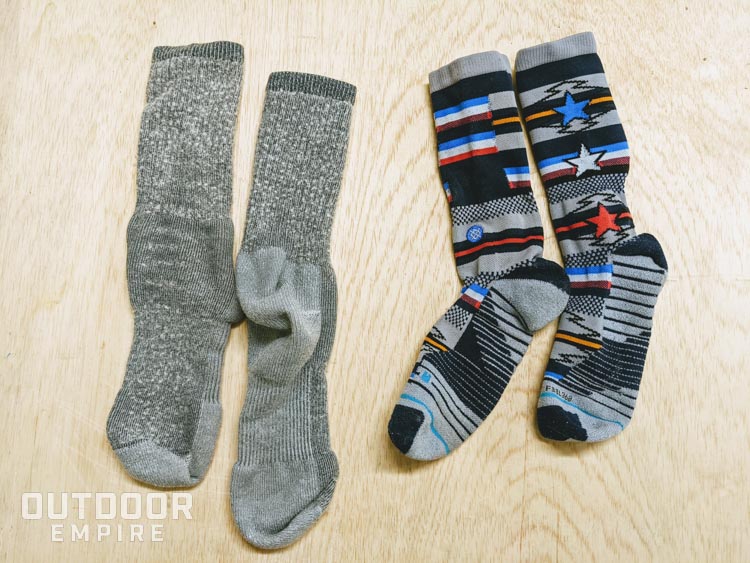
Socks are just as important as shoes when it comes to blisters. It is well worth the money to buy several nice pairs of hiking socks.
Avoid cotton at all costs. Cotton will absorb sweat and keep that moister next to your feet accelerating blister formation.
2. Break In Your Hiking Boots
If you are planning a long trip over multiple days with a pack, prepare your feet in advance. Your feet need time to adjust and toughen up, especially if you sit at a desk all day in normal life.
Wear the boot and sock combo on walks around your neighborhood trails to break in the boots. Take care of any problems that you find right away. Find terrain that is similar to your planned objective if possible.
3. Keep Your Feet Dry and Clean
While on the trip make sure that you are taking care of your feet. Keep them dry and clean.
Change into clean socks every day. On multi-day trips I bring 3 pairs of socks. Two pairs of socks to hike in and one pair that I only wear to bed. On day one I wear the first pair of socks. On the second day I wash and dry the first pair while wearing the second pair. Wash, rinse, repeat for as long as needed so that every day you start with clean socks.
If you choose the right footwear for your objective, get the right fit, wear appropriate socks and take care of your feet along the way, you should be well on your way to a safe, fun and blister-free adventure.

